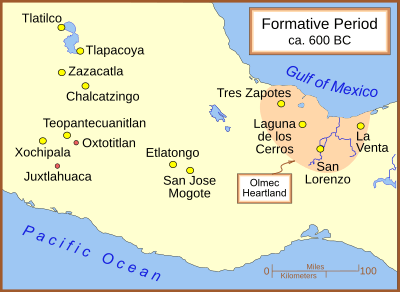Xochipala facts for kids
Xochipala is an important archaeological site in the Mexican state of Guerrero. Its name is also used for a special style of ancient figurines and pottery. These items were made between 1500 and 200 BCE, during the Formative Period. The actual Xochipala site itself dates to later times, from about 200 to 1400 CE. This period includes the Classic and Postclassic eras.
Contents
Exploring the Xochipala Site
The archaeological area is called Organera Xochipala. It gets its name from the nearby village of Xochipala and a local plant, the organ pipe cactus. This site is mainly from the Classic and Postclassic eras, between 200 and 1400 CE.
In the mid-1900s, many valuable items were taken from this site. It is part of the Mezcala culture. Experts believe about 20,000 pieces were removed. Most of the stone sculptures found here have been studied after appearing in art collections.
The Xochipala area is famous for its unique figurines and stone bowls. These items are from the Formative (or Preclassic) Period, which was from 1500 to 200 BCE.
A special discovery at the site was a corbelled arch. This type of arch was thought to be an invention of the Maya people. Scientists are still studying if this arch was created in Guerrero independently. They also wonder if the idea came from the Maya regions.
About six kilometers south of Xochipala town is a group of mounds called Las Mesas. Some important large stone carvings were found there.
Amazing Ancient Figurines
The Xochipala style is known for some of the earliest and most realistic figurines from ancient Mesoamerica. There are also many bowls carved from very hard stone.
The first Xochipala-style figurine found again was bought in Guerrero in 1897. It was later sold to the Peabody Museum in 1903. Sadly, no Xochipala figurine has been found in its original buried spot yet. They have only been found through collectors and art dealers.
The earliest date for a figurine is 1500 BCE. But without knowing where it was found, dating is based on its style and how it was made.
Many figurines were first shaped without clothes. Then, clothing was added on top, almost like an applique. Some experts think the nude figurines might have been dressed in clothing that has since disappeared.
What Experts Say About Xochipala Art
Experts highly praise these early figurines:
- "Near Xochipala a number of solid clay statuettes have been found dating from about 1300 BC, but modelled with a sureness of hand, a sensitivity to three-dimensional form, and a liveliness that suggests a well-established tradition." — Hugh Honour
- "Expressive gestures, naturalistic forms of hair, and plastic arms and legs make early and rare Xochipala figures among the finest ceramic works of the ancient New World". — Mary Ellen Miller
- ". . . some of the most imaginative, lively, and naturalistic figuines yet known in Mesoamerica". — David Grove
- "This small group constitutes some of the greatest miniature ceramic sculpture made in the Americas. The figures stand out in intensity and naturalism from all other works." "These primal works of superb technical virtuosity represent some of the greatest ceramic figurines in all of the vast body of Mesoamerican art." — Gillett Griffin
Were They Olmec?
In 1972, a researcher named Carlo Gay suggested that the amazing Xochipala figurines came from a very early culture. He thought this culture was older than the Gulf coast Olmecs. Gay believed that the realistic "Early Xochipala" figurines slowly led to the more styled "Late Xochipala" art. This, he thought, then led to what archaeologist Gillett Griffin called "abstracted" Olmec art.
However, many experts do not agree with Gay's idea. They find few similarities between Xochipala figurines and Olmec art. David Grove noted that only a few Olmec features appear in some Xochipala pieces. But these features are mostly missing from Xochipala art. Michael Coe also saw nothing in Xochipala art that would lead to the Olmec style. Today, Gay's idea is not widely accepted.
David Grove offered another idea for why Xochipala art was so advanced. He suggested that the earliest figurines were influenced by advanced pottery traditions from northern South America. However, this idea is also not widely accepted by archaeologists.
See also
 In Spanish: Xochipala para niños
In Spanish: Xochipala para niños


